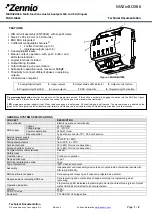
IWAC Display
http://www.zennio.com
Technical Support:
http://support.zennio.com
12
Heartbeat (Periodical Alive Notification)
: incorporates a one-bit object to
the project (“
[Heartbeat] Object to Send ‘1’
”) that will be sent periodically
with a value of “1” to notify that the device is still working (still
alive
).
Figure 5.
Heartbeat (Periodical Alive Notification).
Note
:
The first sending after download or bus failure takes place with a delay
of up to 255 seconds, to prevent bus overload. The following sendings match
the period set
.
Room State Objects:
incorporates some communication objects to control
the room status. These objects are:
➢
“Room State: Control”
(1 byte): allows changing the room status. The
values available are: 0 = Normal, 1 = Make Up, 2 = Do Not Disturb.
➢
“Room State: Make Up Room (Status)”
(1 bit): indicates whether the
room is in “Make Up” status (‘1’) or not (‘0’).
➢
“Room State: Do Not Disturb (Status)”
(1 bit): indicates whether the
room is in “Do Not Disturb” status (‘1’) or not (‘0’).
Refer to section 2.4 to see icons associated to each status.
Sounds:
incorporates the object
“
Sound
” to enable/disable sound at runtime.
It is possible to parameterise the
object polarity
(“0 = Disable; 1 = Enable” o
“0 = Enable; 1 = Disable”).
The project topology shows the following objects by default:
“Request Date and Time
”: object to request time and date update.
Important
:
time setting must be done through the bus, by means of an
external reference.












































